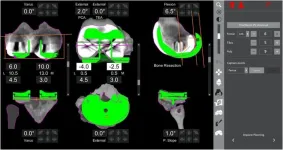Next generation spinal fusion goes "meta"
Pitt Engineer receives $557K NIH funding for world’s first in vivo trials of metamaterial orthopedic implants
2024-01-17
(Press-News.org) A civil engineer at the University of Pittsburgh is applying his expertise in bridges and infrastructure to develop new materials that better treat spinal injury, repair, and recovery. Amir Alavi’s proposal received a $557,000 boost from the National Institutes of Health to test the first “metamaterial” orthopedic implants.
With an estimated 342,000 procedures per year in the U.S.1, interbody spinal fusion is a popular procedure to treat a range of spinal pain and injuries, from herniated discs and degenerative diseases to trauma. Interbody fusion cages are spinal implants that are used in most of these procedures for better surgical outcomes. A successful fusion is also a balancing act – the cage should be stiff and strong enough to limit motion and relieve pressure, yet soft enough that the spine can still act to transfer load. However, the required strength and stiffness provided by the current materials used in the fusion procedures can negatively impact the healing progress.
“Titanium and specific polymers, like polyetheretherketone (PEEK), are the most common materials used in spinal fusion cages because of their biocompatibility, strength, and durability. While one might assume that the high rigidity of metal implants is desirable, it actually can lead to detrimental outcomes such as extreme compression, delayed bone healing, and even catastrophic destruction of the host bone,” explained Alavi, who is an assistant professor of civil and environmental engineering in Pitt’s Swanson School of Engineering. “There are also major concerns regarding the bone integration of PEEK cages”.
Alavi’s NIH funding is from a three-year Trailblazer R21 Award which allows new and early stage investigators to pursue research programs of high interest to the National Institute of Biomedical Imaging and Bioengineering. Alavi is also among 23 University of Pittsburgh scientists included in the 2023 Highly Cited Researchers list from Clarivate and was named one of “24 Pennsylvanians to Watch in 2024” by PennLive/Harrisburg Patriot News.
“I am very excited about this project as it marks the first-ever testing of a “metamaterial orthopedic implant” in vivo,” Alavi added. “Our mission is to discover the ideal interbody fusion cage—a holy grail that combines the necessary stiffness for stabilizing vertebrae movement, flexibility for load-sharing, and porosity to support both bone on-growth and in-growth. I believe that our metamaterial approach to designing interbody fusion cages is the most viable strategy to seamlessly integrate all these essential features into a single fusion cage.”
According to Alavi, metamaterials are more advanced than traditional elements, alloys, or other materials because they can be designed to provide a wide range of desired mechanical properties, including ultra-light, ultra-stiff, ultra-high strength‐to‐density ratios, compliance, and high resilience. In addition, metamaterial implants open a vast design space as they can be fabricated using a wide variety of biocompatible materials.
The team is leveraging their generative artificial intelligence tools to accelerate the exploration of this design space, with tools that allow researchers like Alavi to utilize massive amounts of data not only about metamaterials, but also the spine and how the material needs to behave within the human body.
“The unit cells in these metamaterial implants can take various sizes and shapes. The number of possible configurations for these metamaterial implant can approach astronomical values. So, depending on the clinical requirements, target mechanical properties and anatomical matching set by our surgeons, we are dealing with a huge design space,” Alavi explained. “What generative AI allows us to do is combine all these parameters with every known material to identify a new metamaterial that responds to all medical needs and improves recovery. We can then create the metamaterial constructs and test them much more quickly, efficiently, and economically than traditional trial and error.”
The Trailblazer R21 Award will enable Alavi to first test the spinal fusion cages on animals before finalizing the treatment for human testing. He believes the process will eventually lead to the next-generation metamaterial-based implants that can be used for treatment of other bone injuries and diseases requiring surgical intervention. His collaborator during the in vivo trials will be Allegheny General Hospital.
###
1 “How Many Spinal Fusions are Performed Each Year in the United States?” iData Research, 16 August 2023, https://idataresearch.com/how-many-instrumented-spinal-fusions-are-performed-each-year-in-the-united-states/.
END
ELSE PRESS RELEASES FROM THIS DATE:
2024-01-17
HUNTINGTON, W.Va. - An innovative study at Marshall University published in ArthroplastyToday explores the use of robotic-assisted joint replacement in revision knee scenarios, comparing the pre- and post-revision implant positions in a series of revision total knee arthroplasties (TKA) using a state-of-the-art robotic arm system.
In this retrospective study, the orthopaedic team at the Marshall University Joan C. Edwards School of Medicine and Marshall Health performed 25 revision knee replacements with a robotic assisted computer system. The procedure involved placing new implants at the end of the thighbone and top of the shinbone with the computer's aid to ensure ...
2024-01-17
RIVERSIDE, Calif. -- After COVID vaccination, it usually takes weeks for our bodies to develop protective antibody responses. Imagine, however, a vaccine that speeds up the production of antibodies against SARS-CoV-2, the virus that spreads COVID-19.
A research team led by Rong Hai, an associate professor of microbiology and plant pathology at the University of California, Riverside, has developed such a vaccine by using preexisting immunity to a separate virus (the influenza virus) to help kickstart the process of making antibodies ...
2024-01-17
MINNEAPOLIS – Approximately 23% of people diagnosed with Alzheimer’s disease or another related dementia in their 60s and later have cases that can be explained by controllable risk factors such as high blood pressure, diabetes, physical inactivity, and too little or too much sleep, and that percentage varies depending on race and ethnicity, according to a new study published in the January 17, 2024, online issue of Neurology®, the medical journal of the American Academy of Neurology. When including APOE ε4, a gene variant associated with the strongest genetic risk for late-age Alzheimer’s disease, the study found about a third of cases could be explained ...
2024-01-17
MINNEAPOLIS – Migraine can impact many aspects of a person’s life, but less is known about how feelings of stigma about the disease affect quality of life. For people with migraine, these feelings of stigma were linked to more disability, increased disease burden and reduced quality of life, according to new research published in the January 17, 2024, online issue of Neurology®, the medical journal of the American Academy of Neurology.
“Stigma is common where the disease is not readily apparent to others, and there is indication that it could be especially relevant for those living with migraine,” said study author Robert Evan Shapiro, ...
2024-01-17
WHAT:
Three different HIV antibodies each independently protected monkeys from acquiring simian-HIV (SHIV) in a placebo-controlled proof-of-concept study intended to inform development of a preventive HIV vaccine for people. The antibodies—a human broadly neutralizing antibody and two antibodies isolated from previously vaccinated monkeys—target the fusion peptide, a site on an HIV surface protein that helps the virus fuse with and enter cells. The study, published in Science Translational Medicine, was led by the Vaccine Research Center (VRC) at the National Institute of Allergy and Infectious Diseases (NIAID), part of the National Institutes of Health.
Antibodies ...
2024-01-17
Social networks of sanctuary-living Grauer’s gorillas provide unique insights into the behavior of a critically endangered species and inform on their care and future release.
Adult female gorillas are at the centre of social networks in a sanctuary-living Grauer's Gorilla group, according to social network analysis which also finds them to be the most gregarious.
####
Article URL: https://journals.plos.org/plosone/article?id=10.1371/journal.pone.0295561
Article Title: Group structure and individual relationships of sanctuary-living Grauer’s ...
2024-01-17
In a study of nearly 5,000 North American first-year college students, those who were more extraverted, more agreeable, or less neurotic were more likely to feel a greater sense of belonging at school. Alexandria Stubblebine, an independent researcher in Ocala, Florida, USA, and colleagues present these findings in the open-access journal PLOS ONE on January 17, 2024.
Prior research has suggested that one’s personality traits are associated with one’s general sense of belonging. Within a college-specific context, other research has linked a secure sense of belonging to many positives, such as better academic performance and better mental health. Some studies have investigated ...
2024-01-17
When it comes to trends in mortality over the last thirty years, countries around the world can be grouped into five clusters, roughly representing the five continents, according to a new study published January 17, 2024, in the open-access journal PLOS ONE by David Atance of Universidad de Alcalá, Spain, and colleagues. While the clusters follow different trajectories, they share some commonalities, including longer life expectancies and fewer disparities between genders and groups of countries with different mortality and longevity indicators.
Most countries in the world have seen improvements in longevity over the last two centuries, ...
2024-01-17
Mothers with high levels of dental plaque are 8 times more likely to transfer Candida albicans, involved in tooth decay, to their babies, underlining the need for moms to keep their own teeth clean
###
Article URL: https://journals.plos.org/plosone/article?id=10.1371/journal.pone.0290938
Article Title: Multilocus sequence typing of Candida albicans oral isolates reveals high genetic relatedness of mother-child dyads in early life
Author Countries: Kuwait, USA
Funding: JX; grants K23DE027412 and R01DE031025 from the National Institute of Dental and Craniofacial Research. https://www.nidcr.nih.gov/ The funders ...
2024-01-17
Dancing is an effective way for overweight and obese people to lose weight and fat, per meta-analysis
###
Article URL: https://journals.plos.org/plosone/article?id=10.1371/journal.pone.0296089
Article Title: Is dancing an effective intervention for fat loss? A systematic review and meta-analysis of dance interventions on body composition
Author Countries: China
Funding: We are sure that our funder is the Hunan Provincial Social Science Achievements Evaluation Committee project, the award number is XSP21YBZ163, and the Grant recipient is Longjun Jin. The funder had no role in study design, data collection ...
LAST 30 PRESS RELEASES:
[Press-News.org] Next generation spinal fusion goes "meta"
Pitt Engineer receives $557K NIH funding for world’s first in vivo trials of metamaterial orthopedic implants






